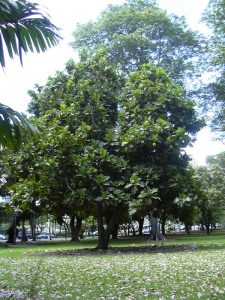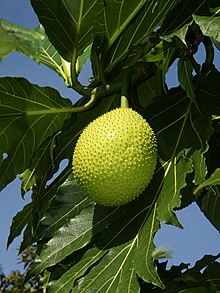Breadfruit, Anyone?NonfictionAlan Gartenhaus

Like Jack and his magnificent beanstalk in the proverbial fairy tale, I watched in amazement as all twelve breadfruit trees climbed to the sky seemingly overnight.
F rom the day I first stood on land at the rural northern tip of Hawaii Island, I had romantic notions of planting fruit trees. Though I had never farmed, it didn’t require much imagination. The area is known for having been King Kamehameha’s garden and is blessed with a year-round growing season, deep, rich soil, and ample rainfall. Within weeks of living there, I had planted a couple of orange and grapefruit trees purchased at the local hardware store, crops familiar from my youth in Louisiana and Florida. It wasn’t long before my vision grew bolder. I wanted to cultivate fruit trees indigenous to the tropics and the Hawaiian Islands. Unsure of which to select, I consulted a friend whose beautiful yard I greatly admired. She recommended I contact a young man who lived out our way and was knowledgeable about the local flora.
Tom arrived dressed in a ratty, tie-dye T-shirt and blousy cotton pants, sporting a long, scraggly beard. I hadn’t expected him to wear a coat and tie but did think of this as an interview, and his casual, youthful appearance had me questioning his experience and his professionalism—until he suggested that I grow breadfruit. The word alone sounded as exotic as the rainforest landscape surrounding my newly adopted home. I’d read Mutiny on the Bounty. I knew about the nourishing fruit. Tom’s praise for the handsome fullness of its trees, their upright stature, giant, sculpted leaves, and rapid growth added further enticement, as did his description of fruit edible at any stage in its development—a food source that, before the introduction of Western diets, had been a staple throughout the tropics, prized for its wealth of vitamins, minerals, and calories. He told me that planting breadfruit would make a substantial contribution to food sustainability on our island. It would serve as a hedge against the precarious food supply here in the middle of the Pacific Ocean. Breadfruit could feed people if the container ships that stocked Hawaiian pantries with Cheerios, peanut butter, Spam, and linguini were ever to stop delivering. That made sense to me, and I told him yes—I would plant breadfruit. I wanted to help feed and sustain our island community.
Weeks went by without a word from Tom. Just when I was about to write him off as a flake, he showed up, his rickety flatbed truck making such a clattering racket as he drove down our gravel driveway that our old dog, who was reluctant to expend energy unless absolutely necessary, raised her head and barked. Flashing a broad smile and a wave, he pulled up beside the house with twelve of the cutest little trees, each bearing a few exquisite, hand-shaped, emerald-green leaves. That afternoon I had great fun running from one spot to the next, spreading my arms, pretending to be a tree and contemplating planting one here and one there. Would the tree frame our view? Would it be vulnerable to the strong winds and rain that sometimes battered this part of the island?
Once all twelve of these adorable saplings were sited, Tom insisted on digging the holes for each by hand. I suggested using the auger attachment to our fancy new tractor, which could drill a hole in mere seconds. Tom warned against the shortcut, saying that drilling glazed the dirt and made it difficult for tender roots to penetrate the soil. So for much of that day, we set young trees beside piles of dirt lovingly removed by hand with shovels. By the time Tom left me to place the saplings in their holes and water them, I had a great sense of satisfaction—and an incredibly sore back, neck, and shoulders.
Weeks later I walked the trusted friend who had grown up on the island around our place, hoping to impress her. After walking from one newly planted tree to the next, she turned to me with an expression of concerned astonishment. “Wow. You’re going to have plenty of ulu,” which is the Hawaiian word for breadfruit.
“You think?” I replied, pleased and prideful.
She smiled coyly. “More than.” She explained that each breadfruit tree was likely to produce more than three hundred pounds of fruit in a single season.
What had I done? Surely Tom must have known how much breadfruit I would be cultivating and would have to harvest, although he had given me no indication. He hadn’t simply enlisted me as a member of a team who’d serve as a hedge against hunger in Hawaii; I was the hedge.

Their yellowish-green skin was leathery and segmented into lumps, giving them the appearance of oversized hand grenades.
Nothing wrong with having lots of breadfruit, I sought to reassure myself. They’ll make great treats to share with friends. Then I remembered folks I’d known who had planted too much zucchini in their backyard gardens and how they used to stack mounds at the desks of co-workers who were out having lunch. Neighbors would lock their cars, not to prevent theft but to prevent bags of zucchini from being dropped into the back seats of their parked cars after refusing any more as outright gifts.
Like Jack and his magnificent beanstalk in the proverbial fairy tale, I watched in amazement as all twelve breadfruit trees climbed to the sky seemingly overnight. Within a year they had filled out, becoming the kind of big, round tree shapes that children draw with crayons. Several months later small, bumpy knobs sprouted at the ends of their many branches. These knobs quickly went from looking like bright-green ping-pong balls to fruit large enough to require two hands to cradle. Were these the promised edible fruit? Nothing about them looked the slightest bit appetizing. Their yellowish-green skin was leathery and segmented into lumps, giving them the appearance of oversized hand grenades.
Recalling Tom’s appealing description of fruit that could be eaten at any stage of its development, I didn’t worry about what constituted prime ripeness. With ritualistic care I selected a fruit that weighed a pound or more. It was attached to the tree by a soft, pliable stem that pruning shears cut easily. I watched the heavy fruit hit the ground with a thud, having passed right through my fingers. As it rolled over the grass, I felt something tapping me on my shoulder; it was white sap oozing from the tree.
I wiped away the sap with my hand and immediately realized that this was no ordinary tree sap but a latex-like goo, sticky enough to bind my fingers together. It made releasing the pruning shear handles a challenge. Washing the goo off proved no easy task either; soap, hot water, and vigorous scrubbing had little effect. (I later learned that the sap from breadfruit trees had been used as a glue for Hawaiian canoes. It was not only a strong adhesive but also waterproof.) Finally I found that I could rub it off once dried, much like rubber cement, though it required considerably more friction.
Though daunted, I remained determined and brought the green, dinosaur-egg-sized fruit into my kitchen and placed it on a cutting board. I got my sharpest long knife. When I pierced the skin, a white teardrop of sap appeared, followed by a stream that immediately fouled the cutting board and rendered the knife blade useless as it stuck to the fruit rather than sliced through it.
Anticipating that I would soon have hundreds of breadfruit, I restrained my “learn by doing” impulse and went to my computer. Apparently the solution to the sap problem was to oil one’s hands and knife before cutting into the fruit. That proved only modestly successful, and precarious. A greasy, slippery knife isn’t the best or most reliable kitchen tool, especially when held in an oily hand. Eventually I stumbled onto a recipe that called for baking the breadfruit whole before cutting into it, as is done during luaus while roasting a pig.
Thinking I’d give that a try, I went back outside, harvested another breadfruit, and placed it whole and unpeeled in a hot oven. It cooked at 450 degrees for well over an hour. As it baked, a pleasant, slightly sweet fragrance filled the house. After removing it from the oven and letting it cool, I pared away the peel and cut the fruit in half without fuss, muss, or goo. I cheered aloud, “The riddle is solved! Breadfruit for the masses!” Victorious, I took a bite. Unfortunately the appeal of the fruit’s pale, spongy inside did not match the allure of its aroma; it had a dry, fibrous texture that was odd and, quite frankly, unpleasant. I found it nearly impossible to swallow without washing it down with a gulp of water, as though a pill.
Desperate to find some way to make the stuff palatable, I chopped up the remainder and dropped it into a food processor along with half a stick of butter. Only after pouring in a quart of milk did the wads and chunks surrender and blend into something akin to whipped potatoes.
After folding in a little grated cheddar cheese, I turned the puree into a casserole dish and baked it again for another forty-five minutes. Assuming that butter, milk, and cheese could make cardboard taste okay, I gave it another try. Beyond okay, it was delicious!
Since then I’ve done a lot of experimenting and learned how to prepare breadfruit in a variety of other ways—breadfruit-potato salads, breadfruit chips, even breadfruit custards and cheesecakes. Since they grow year-round, I routinely serve breadfruit in some fashion to family, friends, and visitors, often to rave reviews, and wait for them to ask if they can take one or two breadfruit home with them. When they do—and they frequently do—I smile, thinking, did you lock your car?
Alan Gartenhaus lives on the island of Hawaii, where he farms and writes fiction after a thirty-year career in the museum profession. His work has appeared in Broad River Review, Diverse Voices Quarterly, Entropy Magazine, Euphony Journal, The Evening Street Review, Green Hills Literary Lantern, Ignatian Literary Magazine, moonShine Review, New English Review, Paragon Journal, Penmen Review, Running Press, Santa Fe Literary Review, and Smithsonian Press.
|


